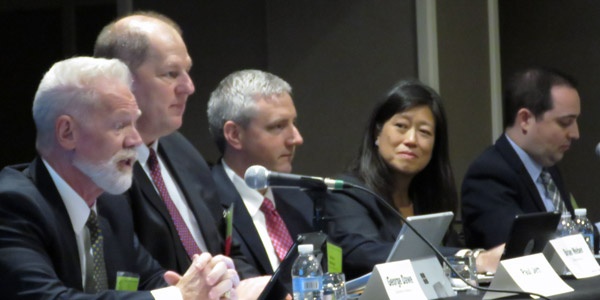By Rich Heidorn Jr.
WASHINGTON — FERC’s Order 1000 is providing savings to ratepayers, but a lack of transparency in RTOs’ competitive solicitations is undermining confidence, and limited opportunities may doom nonincumbent developers, speakers told the Energy Bar Association Mid-Year Energy Forum last week.
The range of comments were similar to those FERC heard at its June technical conference on the landmark rule. More than 60 stakeholders filed post-technical conference comments last week before the deadline Oct. 3 (AD16-18). (See Five Years Later, FERC Takes Another Look at Order 1000.)
“We’re out of the policy debates and into implementation,” said Brian Weber, managing director of transmission development for Transource, a joint venture of American Electric Power and Great Plains Energy.
Weber said it is “too early to make broad brush changes” in the rules, given that some RTOs have yet to complete their first Order 1000 solicitations.
Other speakers at the EBA session saw no need to wait to fix problems.
Paul Jett of Midcontinent MCN, GridLiance’s operating company in MISO, said FERC’s policy is sound, but the implementation “is off to a slow start” because the continued existence of state rights of first refusal and RTOs’ reliability project “carve outs” for incumbents have left an “extremely narrow” set of projects open to competition.
George Dawe, vice president of Duke-American Transmission Co., echoed Jett’s complaint, saying incumbent transmission owners weren’t the only ones to oppose competition. RTOs don’t like it, Dawe said, because “they’re in the spot of having to pick winners and losers.”
“So we end up with these design flaws … created in the very beginning because those two entities in particular didn’t want competition in the first place. And so you end up with arbitrary voltage thresholds, cost allocation issues [and] limited benefit metrics to determine which project should be eligible” for competition.
FERC needs to “course correct,” he said, by reassigning the competitive selection job from the RTOs to their Market Monitors.
Transparency

Dawe and other speakers also said more transparency is needed to increase confidence in the selection process.
Weber said that’s one reason his company likes the sponsorship model used by PJM rather than the practice in CAISO, where the ISO accepts competitive bids on a solution developed by its engineers.
“You propose your solution and if your solution is the best solution it saves the need for all the issues which may come with more of a competitive bid process,” Weber said.
“There are some regions that have issued very subjective criteria — multiple criteria — but really only give one of the criteria that they’ve issued,” he continued. “So that leaves you in a situation at the end where you can’t draw a straight line between the end result and what was communicated up front.”
Weber contended competition should be limited to capital costs, saying the inclusion of operations and maintenance and tax considerations introduces too much subjectivity into the evaluation.
“We’ve been involved in certain regions where … you put everything in an Excel spreadsheet, there’s a multi-hundred-page contract behind it that covers every potential outcome and the decision is made on a single cell in [the] spreadsheet.”
Shakeout Coming?

Judy Chang of The Brattle Group said the introduction of competition and cost caps is providing benefits to ratepayers, a conclusion with which other speakers agreed.
“Cost containment and cost caps … look to be the new normal,” Dawe said. “It’s hard to imagine there would be a successful bid that doesn’t include some form of containment.”
Brattle says annual transmission spending has increased since FERC issued Order 1000 in 2011. It predicts $120 billion to $160 billion in transmission investments over the next decade.
But that may not be enough for the growing number of independent transmission developers, Jett said. “If you’re a developer and Order 1000 transmission projects are your only path to success, you’ve got a problem today,” he said.
“If these design issues are not addressed quickly, I have to wonder how long will developers be able to hang on.”






